Juvenile Delinquency and Justice Essay
VerifiedAdded on 2020/02/24
|5
|1145
|99
Essay
AI Summary
This essay discusses the various forms of bullying experienced by Amanda Todd, the psychological consequences of such bullying, and the strategies that could have been employed by parents and teachers to prevent her tragic outcome. It highlights the similarities and differences in bullying over the years and identifies factors that contribute to bullying behavior in children.
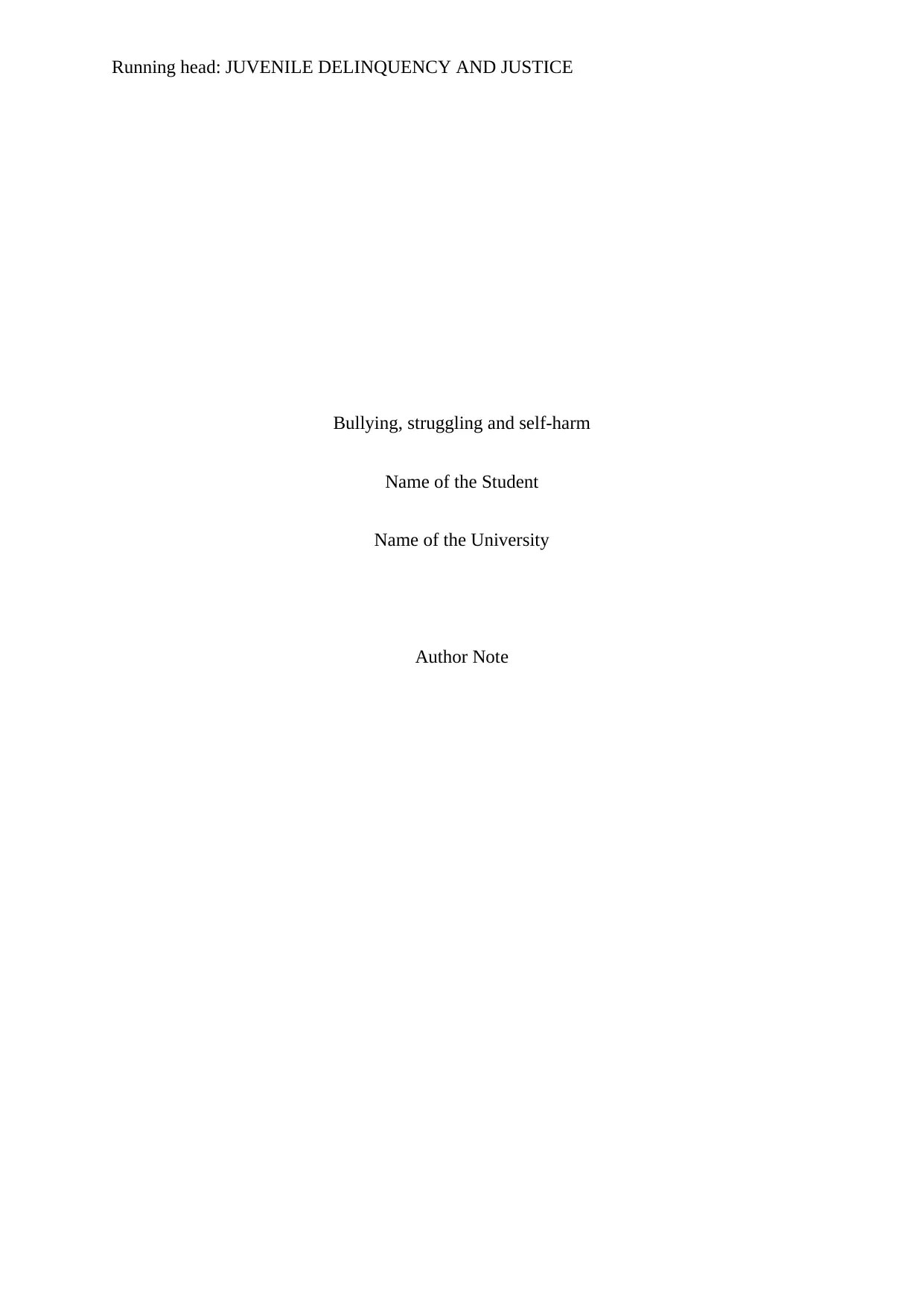
Running head: JUVENILE DELINQUENCY AND JUSTICE
Bullying, struggling and self-harm
Name of the Student
Name of the University
Author Note
Bullying, struggling and self-harm
Name of the Student
Name of the University
Author Note
Paraphrase This Document
Need a fresh take? Get an instant paraphrase of this document with our AI Paraphraser
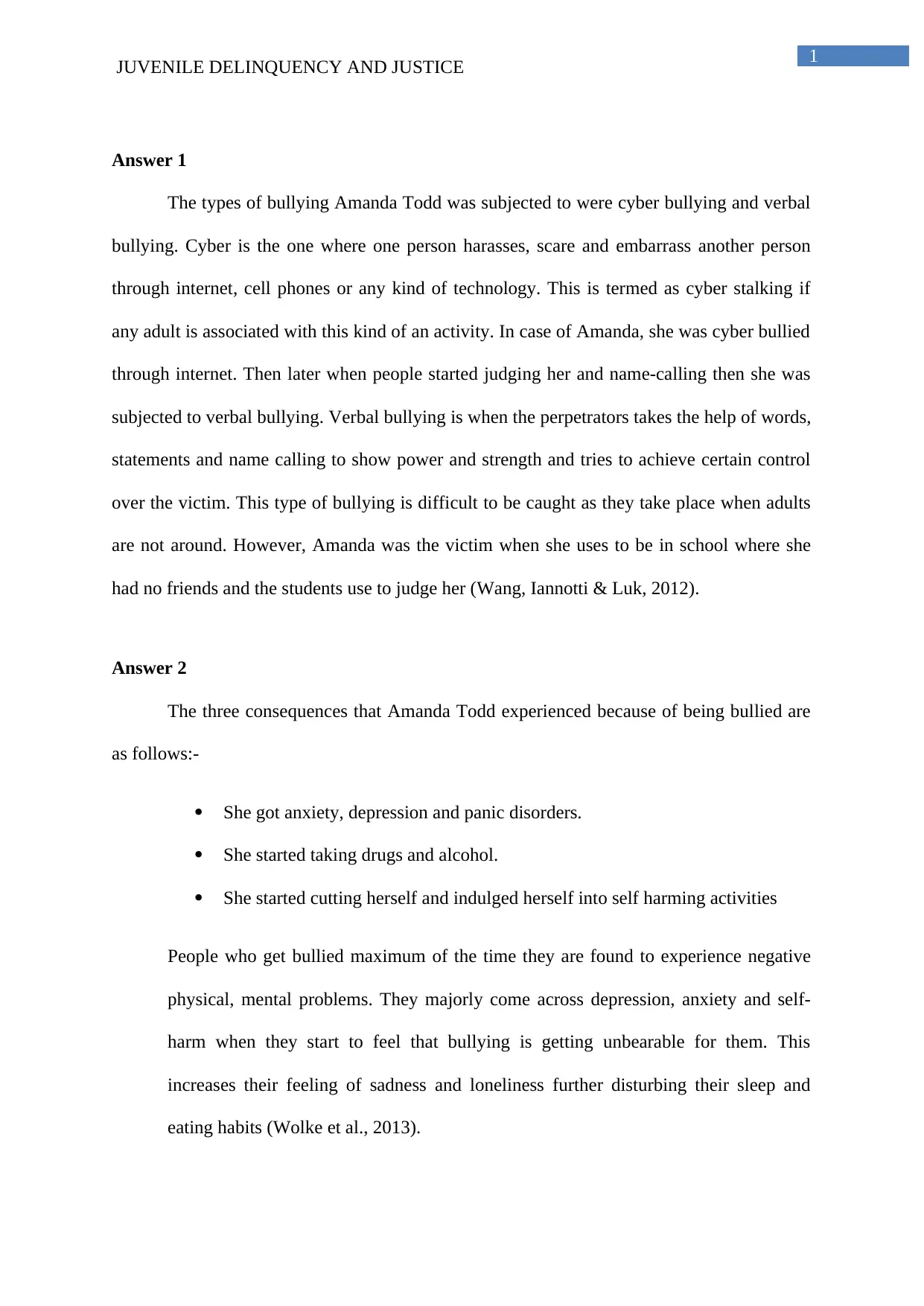
1
JUVENILE DELINQUENCY AND JUSTICE
Answer 1
The types of bullying Amanda Todd was subjected to were cyber bullying and verbal
bullying. Cyber is the one where one person harasses, scare and embarrass another person
through internet, cell phones or any kind of technology. This is termed as cyber stalking if
any adult is associated with this kind of an activity. In case of Amanda, she was cyber bullied
through internet. Then later when people started judging her and name-calling then she was
subjected to verbal bullying. Verbal bullying is when the perpetrators takes the help of words,
statements and name calling to show power and strength and tries to achieve certain control
over the victim. This type of bullying is difficult to be caught as they take place when adults
are not around. However, Amanda was the victim when she uses to be in school where she
had no friends and the students use to judge her (Wang, Iannotti & Luk, 2012).
Answer 2
The three consequences that Amanda Todd experienced because of being bullied are
as follows:-
She got anxiety, depression and panic disorders.
She started taking drugs and alcohol.
She started cutting herself and indulged herself into self harming activities
People who get bullied maximum of the time they are found to experience negative
physical, mental problems. They majorly come across depression, anxiety and self-
harm when they start to feel that bullying is getting unbearable for them. This
increases their feeling of sadness and loneliness further disturbing their sleep and
eating habits (Wolke et al., 2013).
JUVENILE DELINQUENCY AND JUSTICE
Answer 1
The types of bullying Amanda Todd was subjected to were cyber bullying and verbal
bullying. Cyber is the one where one person harasses, scare and embarrass another person
through internet, cell phones or any kind of technology. This is termed as cyber stalking if
any adult is associated with this kind of an activity. In case of Amanda, she was cyber bullied
through internet. Then later when people started judging her and name-calling then she was
subjected to verbal bullying. Verbal bullying is when the perpetrators takes the help of words,
statements and name calling to show power and strength and tries to achieve certain control
over the victim. This type of bullying is difficult to be caught as they take place when adults
are not around. However, Amanda was the victim when she uses to be in school where she
had no friends and the students use to judge her (Wang, Iannotti & Luk, 2012).
Answer 2
The three consequences that Amanda Todd experienced because of being bullied are
as follows:-
She got anxiety, depression and panic disorders.
She started taking drugs and alcohol.
She started cutting herself and indulged herself into self harming activities
People who get bullied maximum of the time they are found to experience negative
physical, mental problems. They majorly come across depression, anxiety and self-
harm when they start to feel that bullying is getting unbearable for them. This
increases their feeling of sadness and loneliness further disturbing their sleep and
eating habits (Wolke et al., 2013).
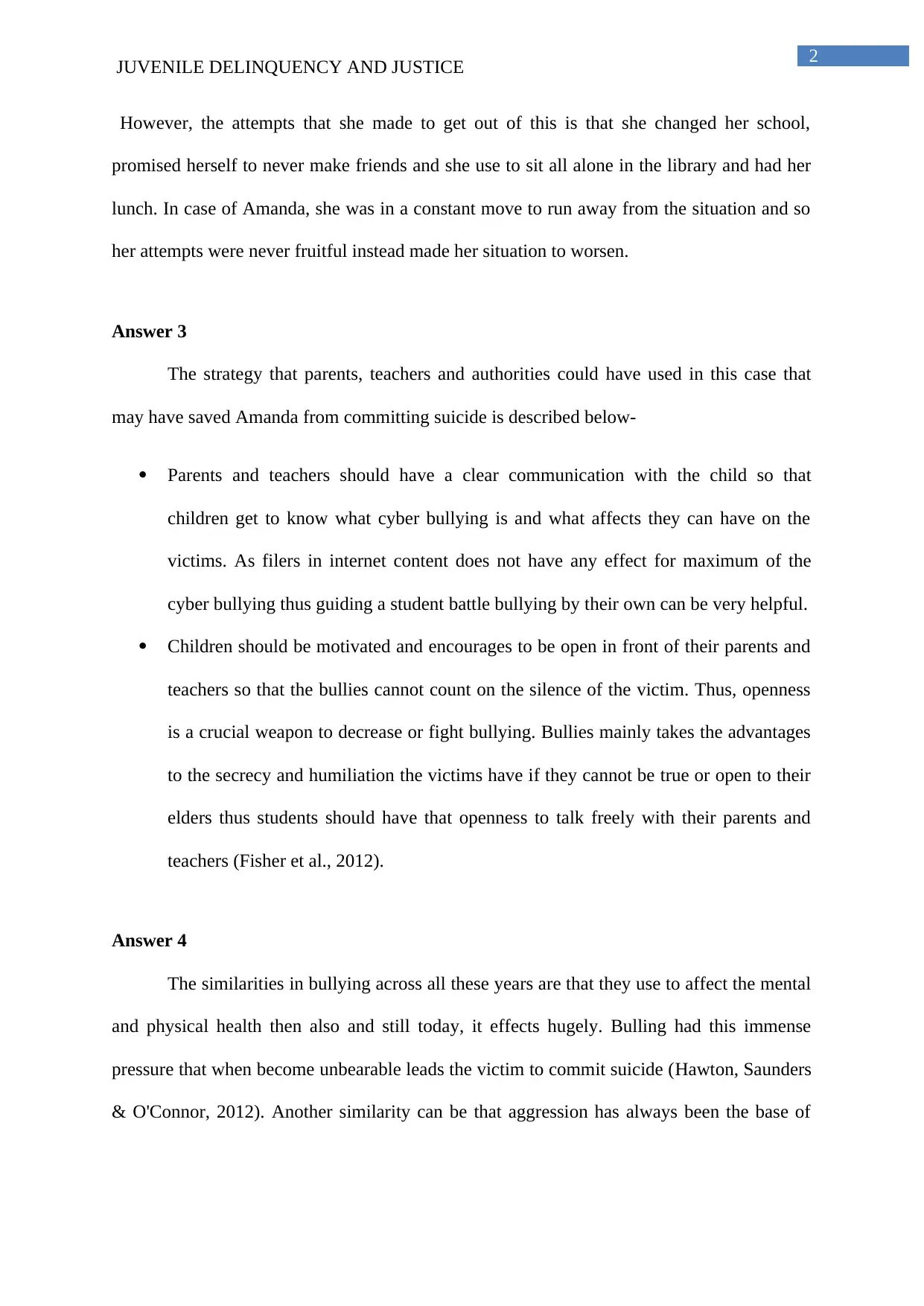
2
JUVENILE DELINQUENCY AND JUSTICE
However, the attempts that she made to get out of this is that she changed her school,
promised herself to never make friends and she use to sit all alone in the library and had her
lunch. In case of Amanda, she was in a constant move to run away from the situation and so
her attempts were never fruitful instead made her situation to worsen.
Answer 3
The strategy that parents, teachers and authorities could have used in this case that
may have saved Amanda from committing suicide is described below-
Parents and teachers should have a clear communication with the child so that
children get to know what cyber bullying is and what affects they can have on the
victims. As filers in internet content does not have any effect for maximum of the
cyber bullying thus guiding a student battle bullying by their own can be very helpful.
Children should be motivated and encourages to be open in front of their parents and
teachers so that the bullies cannot count on the silence of the victim. Thus, openness
is a crucial weapon to decrease or fight bullying. Bullies mainly takes the advantages
to the secrecy and humiliation the victims have if they cannot be true or open to their
elders thus students should have that openness to talk freely with their parents and
teachers (Fisher et al., 2012).
Answer 4
The similarities in bullying across all these years are that they use to affect the mental
and physical health then also and still today, it effects hugely. Bulling had this immense
pressure that when become unbearable leads the victim to commit suicide (Hawton, Saunders
& O'Connor, 2012). Another similarity can be that aggression has always been the base of
JUVENILE DELINQUENCY AND JUSTICE
However, the attempts that she made to get out of this is that she changed her school,
promised herself to never make friends and she use to sit all alone in the library and had her
lunch. In case of Amanda, she was in a constant move to run away from the situation and so
her attempts were never fruitful instead made her situation to worsen.
Answer 3
The strategy that parents, teachers and authorities could have used in this case that
may have saved Amanda from committing suicide is described below-
Parents and teachers should have a clear communication with the child so that
children get to know what cyber bullying is and what affects they can have on the
victims. As filers in internet content does not have any effect for maximum of the
cyber bullying thus guiding a student battle bullying by their own can be very helpful.
Children should be motivated and encourages to be open in front of their parents and
teachers so that the bullies cannot count on the silence of the victim. Thus, openness
is a crucial weapon to decrease or fight bullying. Bullies mainly takes the advantages
to the secrecy and humiliation the victims have if they cannot be true or open to their
elders thus students should have that openness to talk freely with their parents and
teachers (Fisher et al., 2012).
Answer 4
The similarities in bullying across all these years are that they use to affect the mental
and physical health then also and still today, it effects hugely. Bulling had this immense
pressure that when become unbearable leads the victim to commit suicide (Hawton, Saunders
& O'Connor, 2012). Another similarity can be that aggression has always been the base of
⊘ This is a preview!⊘
Do you want full access?
Subscribe today to unlock all pages.

Trusted by 1+ million students worldwide
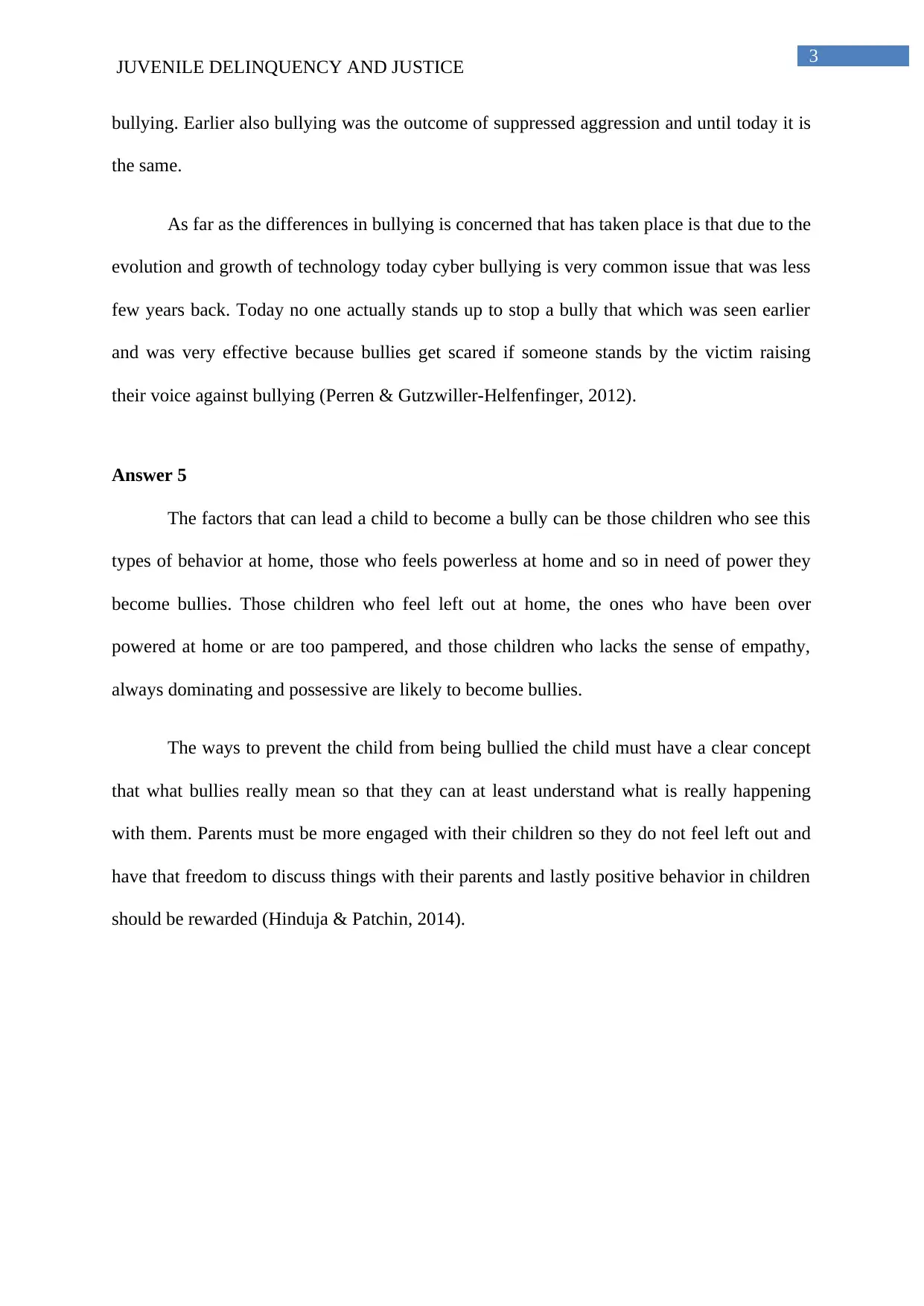
3
JUVENILE DELINQUENCY AND JUSTICE
bullying. Earlier also bullying was the outcome of suppressed aggression and until today it is
the same.
As far as the differences in bullying is concerned that has taken place is that due to the
evolution and growth of technology today cyber bullying is very common issue that was less
few years back. Today no one actually stands up to stop a bully that which was seen earlier
and was very effective because bullies get scared if someone stands by the victim raising
their voice against bullying (Perren & Gutzwiller-Helfenfinger, 2012).
Answer 5
The factors that can lead a child to become a bully can be those children who see this
types of behavior at home, those who feels powerless at home and so in need of power they
become bullies. Those children who feel left out at home, the ones who have been over
powered at home or are too pampered, and those children who lacks the sense of empathy,
always dominating and possessive are likely to become bullies.
The ways to prevent the child from being bullied the child must have a clear concept
that what bullies really mean so that they can at least understand what is really happening
with them. Parents must be more engaged with their children so they do not feel left out and
have that freedom to discuss things with their parents and lastly positive behavior in children
should be rewarded (Hinduja & Patchin, 2014).
JUVENILE DELINQUENCY AND JUSTICE
bullying. Earlier also bullying was the outcome of suppressed aggression and until today it is
the same.
As far as the differences in bullying is concerned that has taken place is that due to the
evolution and growth of technology today cyber bullying is very common issue that was less
few years back. Today no one actually stands up to stop a bully that which was seen earlier
and was very effective because bullies get scared if someone stands by the victim raising
their voice against bullying (Perren & Gutzwiller-Helfenfinger, 2012).
Answer 5
The factors that can lead a child to become a bully can be those children who see this
types of behavior at home, those who feels powerless at home and so in need of power they
become bullies. Those children who feel left out at home, the ones who have been over
powered at home or are too pampered, and those children who lacks the sense of empathy,
always dominating and possessive are likely to become bullies.
The ways to prevent the child from being bullied the child must have a clear concept
that what bullies really mean so that they can at least understand what is really happening
with them. Parents must be more engaged with their children so they do not feel left out and
have that freedom to discuss things with their parents and lastly positive behavior in children
should be rewarded (Hinduja & Patchin, 2014).
Paraphrase This Document
Need a fresh take? Get an instant paraphrase of this document with our AI Paraphraser
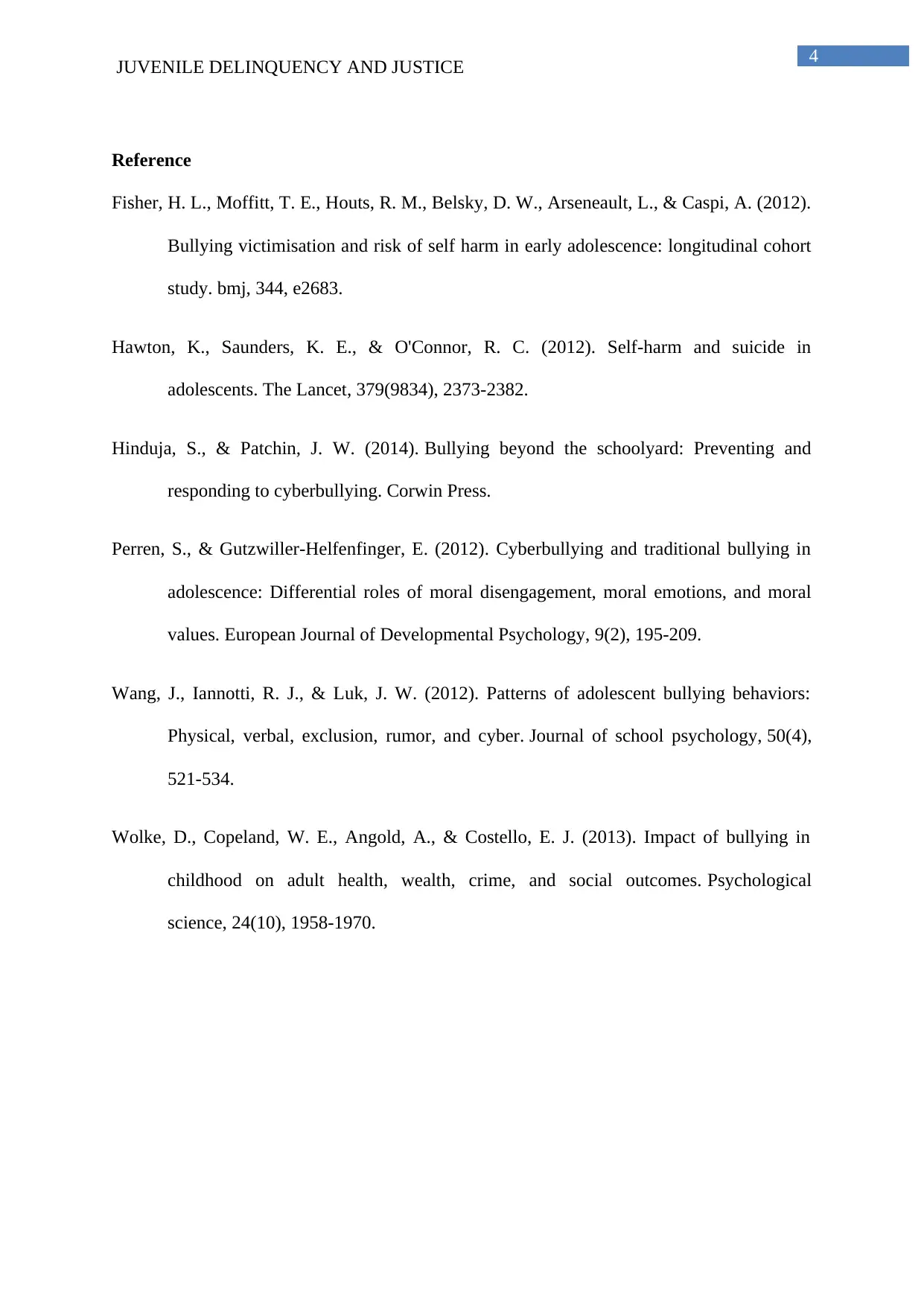
4
JUVENILE DELINQUENCY AND JUSTICE
Reference
Fisher, H. L., Moffitt, T. E., Houts, R. M., Belsky, D. W., Arseneault, L., & Caspi, A. (2012).
Bullying victimisation and risk of self harm in early adolescence: longitudinal cohort
study. bmj, 344, e2683.
Hawton, K., Saunders, K. E., & O'Connor, R. C. (2012). Self-harm and suicide in
adolescents. The Lancet, 379(9834), 2373-2382.
Hinduja, S., & Patchin, J. W. (2014). Bullying beyond the schoolyard: Preventing and
responding to cyberbullying. Corwin Press.
Perren, S., & Gutzwiller-Helfenfinger, E. (2012). Cyberbullying and traditional bullying in
adolescence: Differential roles of moral disengagement, moral emotions, and moral
values. European Journal of Developmental Psychology, 9(2), 195-209.
Wang, J., Iannotti, R. J., & Luk, J. W. (2012). Patterns of adolescent bullying behaviors:
Physical, verbal, exclusion, rumor, and cyber. Journal of school psychology, 50(4),
521-534.
Wolke, D., Copeland, W. E., Angold, A., & Costello, E. J. (2013). Impact of bullying in
childhood on adult health, wealth, crime, and social outcomes. Psychological
science, 24(10), 1958-1970.
JUVENILE DELINQUENCY AND JUSTICE
Reference
Fisher, H. L., Moffitt, T. E., Houts, R. M., Belsky, D. W., Arseneault, L., & Caspi, A. (2012).
Bullying victimisation and risk of self harm in early adolescence: longitudinal cohort
study. bmj, 344, e2683.
Hawton, K., Saunders, K. E., & O'Connor, R. C. (2012). Self-harm and suicide in
adolescents. The Lancet, 379(9834), 2373-2382.
Hinduja, S., & Patchin, J. W. (2014). Bullying beyond the schoolyard: Preventing and
responding to cyberbullying. Corwin Press.
Perren, S., & Gutzwiller-Helfenfinger, E. (2012). Cyberbullying and traditional bullying in
adolescence: Differential roles of moral disengagement, moral emotions, and moral
values. European Journal of Developmental Psychology, 9(2), 195-209.
Wang, J., Iannotti, R. J., & Luk, J. W. (2012). Patterns of adolescent bullying behaviors:
Physical, verbal, exclusion, rumor, and cyber. Journal of school psychology, 50(4),
521-534.
Wolke, D., Copeland, W. E., Angold, A., & Costello, E. J. (2013). Impact of bullying in
childhood on adult health, wealth, crime, and social outcomes. Psychological
science, 24(10), 1958-1970.
1 out of 5
Related Documents
Your All-in-One AI-Powered Toolkit for Academic Success.
+13062052269
info@desklib.com
Available 24*7 on WhatsApp / Email
![[object Object]](/_next/static/media/star-bottom.7253800d.svg)
Unlock your academic potential
Copyright © 2020–2025 A2Z Services. All Rights Reserved. Developed and managed by ZUCOL.





